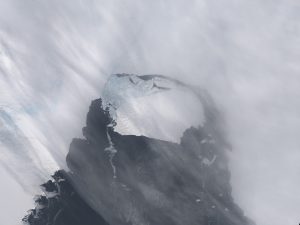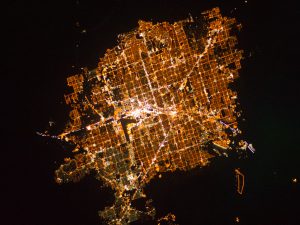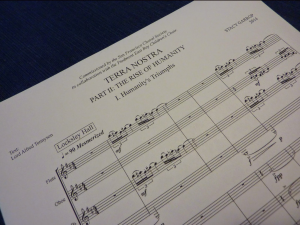CUSO will be joined by the University of Illinois Oratorio Society, Central Illinois Children’s Chorus, and soloists Sarah Gartshore, Betany Coffland, Steven Soph, and David Govertson to give the Midwest premiere of my TERRA NOSTRA on Saturday, March 9th in Foellinger Great Hall.
When I originally wrote the oratorio in 2014-2015, I wrote a series of blog posts about its creation process. I will be re-posting these here in the days leading up to CUSO’s performance, so that audiences can read about its creation process.
Originally posted on October 4, 2014 on www.composerinklings.com
 Writing the middle third of my oratorio reminds me of the middle movies of trilogies. The Empire Strikes Back, Back to the Future II, The Matrix Reloaded – I remember watching each of these in a movie theater, enjoying the ride and leaving the theater filled with excitement to see the final chapter. Middle-of-trilogy movies focus on developing the story line while also providing enough tantalizing plot twists to make an audience want to return. This is usually achieved by a major revelation or cliffhanger near the end of the movie, something that will sustain an audience goer through the long months before they can watch the final installment and achieve a sense of closure. In short, these movies build anticipation. Darth Vader is Luke’s father? Dr. Emmet Brown (i.e. Doc) has accidentally transported himself back to the Old West? Neo is just part of the Matrix’s programming to keep the humans under control? Nooo! These mysteries pique the audience’s curiosity, leaving audiences hungering to know how it all resolves.
Writing the middle third of my oratorio reminds me of the middle movies of trilogies. The Empire Strikes Back, Back to the Future II, The Matrix Reloaded – I remember watching each of these in a movie theater, enjoying the ride and leaving the theater filled with excitement to see the final chapter. Middle-of-trilogy movies focus on developing the story line while also providing enough tantalizing plot twists to make an audience want to return. This is usually achieved by a major revelation or cliffhanger near the end of the movie, something that will sustain an audience goer through the long months before they can watch the final installment and achieve a sense of closure. In short, these movies build anticipation. Darth Vader is Luke’s father? Dr. Emmet Brown (i.e. Doc) has accidentally transported himself back to the Old West? Neo is just part of the Matrix’s programming to keep the humans under control? Nooo! These mysteries pique the audience’s curiosity, leaving audiences hungering to know how it all resolves.
I considered plot development and use of anticipation while composing Part II: The Rise of Humanity of Terra Nostra, my oratorio-in-progress. In Part I: The Creation of the World, I set texts that explore the birth and beauty of our planet. In Part II, I chose poetry that celebrates mankind’s industrial advances (the invention of the steam engine, automobile, and airplane) while at the same time noting the impact these are taking on the planet. The texts regarding industrial progress are joined together into a single movement that comprises the first half of Part II. This music is very joyful, rhythmic, and mechanical, with the tenor and baritones soloists frequently interspersing with the chorus. The latter music in Part II, however, turns quite dark. The soprano and alto soloists sing a duet to Gerard Manley Hopkins’ “Binsey Poplars” about a beautiful landscape that is being demolished for industrial needs. In this hushed movement, the soloists are accompanied by strings that mournfully slide between their pitches to represent grief for the planet (here is an excerpt):
 When we hew or delve:
When we hew or delve:
After-comers cannot guess the beauty been.
Ten or twelve, only ten or twelve
Strokes of havoc unselve
The sweet especial scene,
Rural scene, a rural scene,
Sweet especial rural scene.
Part II concludes with the chorus and soloists singing “A Dirge” by Percy Bysshe Shelley. The text depicts a world that is out of kilter:
Rough wind, that moanest loud
Grief too sad for song;
Wild wind, when sullen cloud
Knells all the night long;
Sad storm whose tears are vain,
Bare woods, whose branches strain,
Deep caves and dreary main,—
Wail, for the world’s wrong!
 To accompany these words, I crafted restless, creepy-sounding music filled with moaning sounds, ominous trills, and instruments that play out of sync with each other. The music becomes increasingly unstable as I build tension to a chaotic climax, after which the music quickly drops to a whimper and dies out.
To accompany these words, I crafted restless, creepy-sounding music filled with moaning sounds, ominous trills, and instruments that play out of sync with each other. The music becomes increasingly unstable as I build tension to a chaotic climax, after which the music quickly drops to a whimper and dies out.
As in movies, I present a plot development in Part II: The Rise of Humanity that is not resolved until Part III: Searching for Balance. Mankind is taking its toll on the earth and its resources; what can be done and where do we go from here? If I’ve done my job right, audiences will come back to hear the conclusion of the oratorio.
Part I: The Creation of the World premieres November 15th and 16th in San Francisco with Maestro Robert Geary, San Francisco Choral Society, Piedmont East Bay Children’s Choir, and soloists. Part II: The Rise of Humanity premieres in April 2015, and the oratorio will premiere in its entirety in November 2015. For tickets and further information, please visit the San Francisco Choral Society’s webpage.

 Like Us on Facebook
Like Us on Facebook Watch Us on YouTube
Watch Us on YouTube Join the Email List
Join the Email List